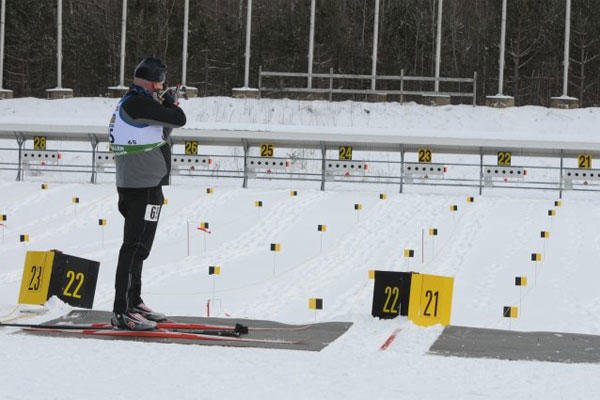JERICHO, Vt. -- You ski as fast as you can over several kilometers of rough terrain with a .22 caliber rifle strapped on your back; then steady that rifle -- controlling your labored breathing and heart rate and shaky legs in mind-numbing cold that freezes your fingers and face. Then you must fire five shots to hit targets the size of 50-cent pieces, 50 meters away.
For the New York Army National Guard Lt. Col. Brian O'Keefe, and Soldier athletes like him, this is the biathlon.
"It's brutal," said O'Keefe of the Nordic event that has been a popular Winter Olympic sport since the Squaw Valley Olympics of 1960.
"It's brutal but relates to everything we do as Soldiers," O'Keefe said. "It combines physical, cardio, and mental stress with precision shooting. It's everything we strive to achieve as Soldiers and much of what we think about when we hear Soldier readiness."
O'Keefe, who finished eighth in the Sprint in his first official outing, represented the New York National Guard at the 2013 National Guard Eastern Regional Biathlon, held Feb. 8-10, 2013, at the Vermont National Guards Camp Ethan Allen Training Site in Jericho, Vt., and has high hopes for encouraging New York National Guard biathletes.
O'Keefe, a Soldiers since 1988, just returned from a 2012 Afghanistan deployment as part of the New York Stability Transition Team, and served in the Civil Military Operations Cell of the 42nd Infantry Division, in Iraq in 2005.
While O'Keefe never competed in biathlon until the Vermont event, he's practiced the sport for fun with friend and former Olympic competitor, retired New York Army National Guard Maj. Curtis "Curt" Schreiner.
Not long ago, New York had a very prosperous biathlon program that developed Olympic-caliber athletes like Schreiner, a three-time Olympic biathlete, O'Keefe said. He would like to see more interest in the sport among Guard members, O'Keefe added.
"I hope that my participation will get others in New York involved so we can rebuild New York's program," O'Keefe said. "I wanted everyone to see that if I can do it, anyone can."
It's not the skill, but the dedication that is the most important characteristic of a Soldier biathlete, O'Keefe said.
"Anyone can do it. Army, Air Force, male or female. If this old man can do it, anyone can. It's the dedication that's most important. The skiing and the shooting will come with time and practice," he said.
"No experience is necessary," O'Keefe emphasized.
Biathlon obviously develops Soldiers marksmanship and skiing skill, Schreiner said. It also teaches competitors to set goals, establish a plan to reach those goals, and work hard at the plan, he added.
According to Maj. Christopher Ruggerio, the National Guard Biathlon program coordinator, the biathlon has a long history with the military that can be traced back to the Great Scandinavian War of 1700-1718, where its skills proved vital for military defense. The skills of skiing and shooting also allowed the Finns to fight the Soviet Army to standstill in 1939.
Ruggerio added that the biathlon skills of marksmanship and skiing are practiced to this day by the armed forces of several nations and that many European Olympic Biathletes are current members of their countries' militaries.
"It's a perfect fit for Soldiers," said Ruggerio. "Where else can you find a sport that encompasses everything that we do as Soldiers? It is Soldier readiness."
Ruggerio also added that the National Guard Biathlon program is a win-win for National Guard recruitment and retention as the program offers access to the highest levels of training for those interested in competing at the highest levels the sport has to offer.
It is believed by many that the first biathlon competition was organized circa 1912 by the Norwegian military initially consisting of a 17 kilometer cross-country ski race combined with time penalties incurred for missed targets.
Today's modern biathlon comprises of the sprint (three loops with two shooting stages totaling 7.5-10km), the pursuit (five laps with four shooting stages totaling 10-12.5km), the individual event (five loops with four shooting stages totaling 15-20km), the mass start (five loops with four shooting stages totaling 12.5-15km), and the team relay event (teams of three to four skiers each completing three laps with two shooting stages for a total of 24-30km).
According to the National Guards Biathlon headquarters, the National Guard Biathlon program was turned over by the Active Army in 1973 and boasts more than 30 states participating in the program.
"Right now we have 31 states that participate in the program but we're not stopping there. We want to get all the states involved," said Ruggerio.



























